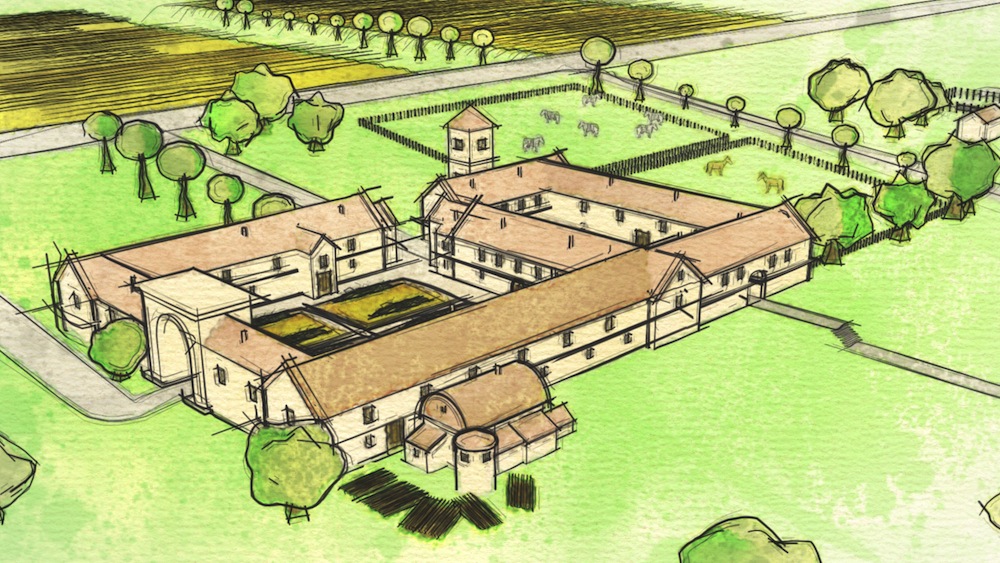When you purchase through links on our site , we may earn an affiliate commission . Here ’s how it mould .
One of Britain ’s best - preserved Roman - age villas was recently discovered beneath a home plate in southwestern England .
Homeowner Luke Irwin , who lives in Wiltshire , desire to run electric cable from his family to an old barn , where his children could play table lawn tennis . But in February , workingman digging a trench for the line strike a unvoiced control surface about 18 inches ( 46 centimetre ) underground .

Archaeologists from Historic England and the Salisbury Museum conducted excavations at the villa site in Wiltshire.
" It was sinful , " Irwin told Live Science . " I was lucky I was there that 24-hour interval . " [ See photograph of the well - preserved Roman villa ]
The worker had uncovered a detailed mosaic flooring .
" The guy rope digging called out and we festinate over . You could immediately see themosaic — the colors were so vivid , it was literally like the twenty-four hour period it was laid , " Irwin said . " There was a sense of disbelief — you are slimly shocked by that moment of the tangibility of chronicle . History is often so aloof and ironical . "

The Roman-age mosaic floor was discovered by workmen digging a trench at Luke Irwin’s home.
Irwin , who has a mania for story , knew that the mosaic was crucial evidence of something much older than the buildings on the place .
" Our house is made from two seventeenth - century laborers ' bungalow knocked together , so there was no path these guys would have put a mosaic in there , " he said .
Irwin called local government officers to scrutinise the find , which lead to an investigation by archaeologist at the Salisbury Museum , in Wiltshire , and Historic England , a government office in the United Kingdom that keep historic construction , monuments and situation .

An artist’s impression of how the double-courtyard villa would have appeared during its heyday in the 3rd and 4th centuries A.D.
The researchers carry out a geophysical view of the site and behave an eight - day investigative dig around the fleck where the mosaic floor was uncovered . What they find was astonishing : below Irwin ’s lawn lay the center of one of the largestRoman villasfound in Britain , which was preserved underground and undisturbed for around 1,400 years .
" It ’s distinctly a very elaborate and very well - to - do residence , " said David Roberts , an archaeologist with Historic England . " The finds , particularly the very fine mosaic that we ’ve found , strongly suggest that it ’s been home to a very moneyed , aristocratic phratry . "
Roberts said the villa seemed to have been occupied since the tardy second C or former third C , until late in the fourth century , a period that corresponds toRoman rule in Britain .

He supply that the villa would have been the economic and social center of a local connection of farming communities , at a time when Britain was an economical mainstay for the Roman Empire in northwestern Europe . [ chronicle ’s 10 Most Overlooked enigma ]
" In the later Roman Empire , Wiltshire is something of a bread basket for the northwest imperium , and texture from the south of England is post to Germany to feed the troop send there , " Roberts told Live Science .
The investigative dig found other artifacts , include coin and " high - status " clayware , a papist well and the stone casket of a Roman child , which had been used as flower bed , he said .

For Irwin , the most moving particular uncovered on his attribute were the personal traces leave behind by people who lived there C ago , such as the remains of a meal ofoystersthat were brought to the villa from the seacoast , 45 miles ( 72 km ) away .
" There ’s something very powerful about the human item , " Irwin said . " I happen the oyster shell peculiarly reminiscent , because you ’re picking up something that was neglect 1,600 age ago — so it ’s literally from one manus to another . "
Irwin , a designer whose work includes sumptuousness rugs , has used the extraordinary uncovering as breathing in for a novel rug aggregation , some incorporate themosaic patternsfrom the site .

" Everything is an adjustment of something that ’s die before , and that makes it a survive cultural particular — it becomes like a bridge across centuries and across cultures , " he say .
Roberts said some of the most interesting finds admit pieces of pottery from the 5th one C , after the official end of Roman convention but before the Saxon conquest of that part of Britain . At that time , the already - abandoned popish Francisco Villa was part refit by masses who erected timber structures inside the bankrupt stone wall , he enunciate .
" It ’s very rare to find well - maintain evidence from the 5th century , the post - popish period , " Roberts said . " In some ways , we have a lot more Roman Doroteo Arango than we have good 5th - century contexts . "

These artifacts from the fifth hundred whirl " such a rarified windowpane into that bit of the past that we do n’t often get a looking at at , " he said .













